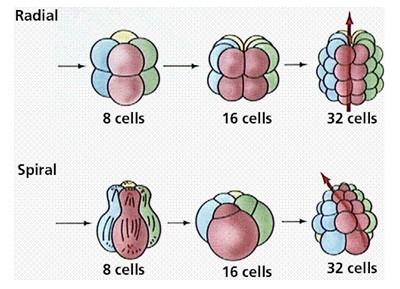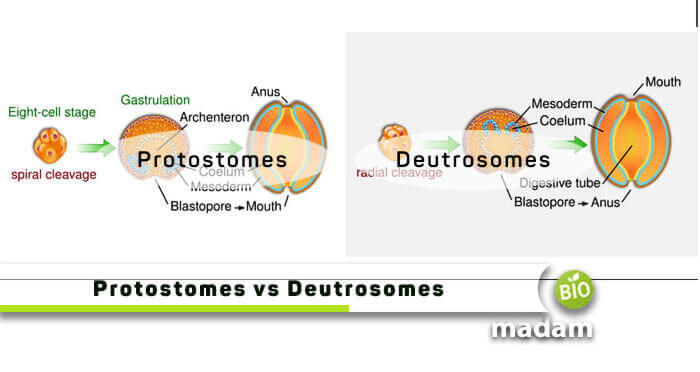Recently updated on March 4th, 2024 at 01:03 pm
A dominant group of animals has bilateral body symmetry, usually called bilaterally symmetrical animals. This symmetry refers to an animal’s body shape that a plane passing through it divides into two halves that are mirror images of each other. These kinds of animals are further divided into two significant groups, named protostomes, and deuterostomes. Such groups refer to protostomy and deuterostomy happing in the early developmental phases of their lives and thus, are differentiated.
Scientists found the first difference between protostomes and deuterostomes at their blastopores, the point of embryonic cleavage. The former creates this blastopore from the mouth whereas, the latter develop it from the anus. Let’s dive into more details of both species to comprehend them better.
Protostomes
A clade of animals undergoing protostomy during embryonic development is called protostomes. The word clade refers to a lineage of an animal and all its ancestors. For example, the main species and all of its descendent species can be considered a clade. A condition in which animals are characterized by the conversion of the first opening of the blastopore into a mouth and then to the complete individual indicates protostomy. Putting it differently, the protostome development includes cleavage from the mouth, which extends further to deepen the pore to develop the gut and anus at the end. The embryonic splitting of such species is spiral in the cells that are determined at an early stage. There is a process known as Schizocoely, which originates coelom through the migration of masses of mesoderm. Different types of arthropods are protostomes, including:
- Insects
- Leeches
- Spiders
- Millipedes & centipedes
- Octopus
- Earthworms
- Crustaceans (lobsters)
- Squids
- Oysters, etc.
Deuterostomes
There is another clade of animals where developmental events follow deuterostomy. This condition often follows a radial cleavage pattern in which the dissecting planes are perpendicular or parallel to the vertical axis. In the initial embryo stages, deuterostomes also exhibit another indefinite cleavage pattern. It displays that an embryonic cell can, anytime, turn out to be a complete embryo if detached from other cells, producing more chances of twin species. Deuterostomes closely relate to the protostomes, with the exception that the first opening of the blastomere becomes the anus in the final organismic body.
Moreover, these vertebrates and invertebrates acquire enterocoelous coelom development where mesoderm originates as archenteron’s lateral out pocketing with hollows befitting the coelomic cavities. Some prominent examples are:
- Amphibians & Reptiles
- Starfish
- Sea Squirts
- Sea Lilies
- Birds
- Humans
- Ascidians
- Fishes, etc.
Difference between Protostomes and Deuterostomes
| Basis of Differences | Protostomes | Deuterostomes |
|---|---|---|
| Pattern of cleavage | Spiral cleavage | Radial cleavage |
| Blastosphere’s first opening | Forms mouth | Forms anus |
| Type of cleavage | Determinate or mosaic cleavage | Indeterminate or regulative cleavage |
| Presence of archenteron in the early stages | No archenteron | Archenteron develops |
| Nervous system | Solid and ventral or Lateral nerve cord | Hollow nerve cord and pharyngeal gill slits, dorsal location |
| Origin of mesoderm | Separate germ layer | Archenteron |
| Phyla | Annelida, Mollusca, Arthropoda, etc. | Chordata, Echinodermata, Vertebra, etc. |
| Cell Cilia | Multi-ciliated | Single-ciliated |
| Examples | Mollusks, Arthropods, octopuses, etc. | Humans, fishes, Ascidians, etc. |
Protostomes vs Deuterostomes
The difference arises as the development of the zygote turns into a complete organism. It starts early in the growth after the gametes i.e., a sperm and an egg (originating from spermatogenesis and oogenesis), fuse to form a zygote, which undergoes further developmental events.
During the very initial events, the zygote is divided in such a way to form two poles. The top pole is known as the ‘animal pole,’ while the bottom one is called the ‘vegetal pole.’
After the formation of poles, further divisions take place in a process named cleavage. This process results in forming a dense ball-like mass of cells, and this specific structure is called blastosphere, and the cells are known as blastomeres.
Now let us take a deep look into how the development leads to these two classes of organisms and the fundamental differences between them.
Cleavage Pattern
One of the primary differences between protostome and deuterostome developments lies in the cleavage method, resulting in the formation of the blastosphere.

Protostomes
In protostomes, the zygote follows a spiral cleavage pattern. It is characterized by the presence of one tier of the blastomeres over the other that the upper-tier lies at the cell junctions of the next tier, which is present on its lower side. In this way, the successive blastomeres form a spiraling structure from one pole to the other.
Deuterostomes
In deuterostomes, the form of cleavage leading to blastosphere formation is called radial cleavage. It is characterized by the presence of one tier of the cells of the blastomeres directly over the preceding tier.
Both of these cleavages are also illustrated in the following figure.
Origin of Mouth and Anus
The mouth and anus origin is another essential feature distinguishing the two classes. We have already discussed the formation of the blastomere, so now let us take a look at what happens next.
As the blastosphere undergoes further changes, the next major event is an indentation on one side known as the blastopore. The next difference between protostomes and deuterostomes lies in the final organ being formed by this blastopore.
Protostomes
The blastopore develops from the mouth, whereas the anus forms on the side opposite to it in protostomes.
Deuterostomes
Contrastingly, vice versa happens in deuterostomes. The anus develops at the blastopore and mouth opposite to the blastopore.
Cleavage Type
The two classes also differ concerning the types of cleavage of the blastomeres when forming the blastosphere. This cleavage has two basic types:
- Determinate/mosaic cleavage (in protostomes)
- Indeterminate/regulative cleavage (in deuterostomes).
Protostomes
These are characterized by the presence of determinate cleavage during the formation of the blastosphere. In such splitting, also called mosaic cleavage, the developmental fate of the cells is already determined during the early developmental events of the embryo.
Deuterostomes
Contrarily, deuterostomes follow the indeterminate type of blastomere cleavage. As the name indicates, in this type of cleavage the fate of the individual cells is not set beforehand. In fact, each cell of the blastosphere has an equal potency to be developed into any cell of an individual. This condition is also known as pluripotency of the cells.
Archenteron Presence
It refers to the presence of a rudimentary alimentary canal formed during the early development of the embryo, more precisely at the gastrula stage.
Protostomes
There is no archenteron development in the protostomes.
Deuterostomes
On the other hand, archenteron forms in the early stages of embryonic development, which is usually developed into the mesoderm and endoderm of the living organism later on.
Nervous System
In both the clades, the nervous system represents a portion of the internalized ectoderm and performs the functions of receiving and integrating the information received from the sensory system. Hence, the presence of different nervous systems is also a distinguishing feature between them.
Protostomes
The protostomes contain a solid nervous system located on either the ventral or lateral side of the body in a solid nerve cord.
Deuterostomes
On the contrary, the nervous system in the deuterostomes is dorsally located in the form of a hollow nerve cord. Moreover, they are also characterized by the presence of pharyngeal gill slits.
Mesoderm Origin
In all bilateral animals, three primary germ layers are formed in the early embryo. One of these is mesoderm, which is the middle layer, and the other two are ectoderm and endoderm (outer and inner layers, respectively).
Protostomes
In these invertebrates, the mesoderm is formed along with ectoderm and endoderm as a separate layer from which a hollow body cavity known as coelom is derived.
Deuterostomes
In deuterostomes, the mesoderm is derived from the archenteron wall, which is an early digestive tract in turn derived from the endoderm of the early embryo.
Bottom Line
Although existing in the same bilateral group, both protostomes and deuterostomes are entirely different. They experience separate embryonic development with the formation of organisms from different sides, i.e., mouth and anus. Hence, protostomes and deuterostomes both have their significance in building a community and ultimately an ecosystem.

Hello, I would like to introduce myself to you! I am Chelsea Rogers, an experienced blog writer for science articles, holding an MPhil degree. My enthusiasm to grab the best knowledge, let it relate to botany, zoology, or any other science branch. Read my articles & let me wait for your words s in the comment section.

